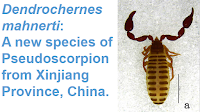The Larcidae is a small family of Pseudoscorpions, comprising 15 species within a single genus, Larca, found in Europe and North America. In North America four species are widely distributed surface dwellers, while five are cave-dwelling species with very limited distributions in the southern United States, while in Europe a single species is widely distributed across northern Europe and four are found in caves in the Mediterranean region.
In a paper published in the journal ZooKeys on 25 April 2024, Mark Harvey of Collections & Research at the Western Australian Museum and the School of Biological Sciences at the University of Western Australia, and David Steinmann of the Department of Zoology at the Denver Museum of Nature & Science, describe a new species of Larca from Mallory Cave, Colorado.
Mallory Cave is located on Dinosaur Mountain to the west of Boulder on the eastern edge of the Rocky Mountains. It comprises a single chamber approximately 25 m wide and 7 m deep, with a single entrance facing to the east. The cave has been gated since 2011 to protect a breeding colony of Townsend’s Big-eared Bats, Corynorhinus townsendii, the population of which had fallen to 10 individuals in 2008-9 and risen to over 60 by 2023.
The new species is named Larca boulderica, where 'boulderica' refers to Boulder County, where the species was found. It is described from seven specimens (two male and five female) collected from Packrat nests within Mallory Cave in 2008 and 2009 after the Bats had left for the winter.
Specimens of Larca boulderica are yellowish brown in colour, with the legs and the genital region of females being paler. Male specimens are between 2.25 and 2.37 mm in length, while females are between 2.51 and 2.74 mm. The cuticle of these Pseudoscorpions is granulated. Venom apparatus are found on both fingers of the pedipalps (claws), with 30 teeth on the fixed fingers of both sexes, while the males have 29 teeth on the movable finger and the females have 28.
The distribution of Larca is similar in both North America and Europe, with widely distributed, surface-dwelling species found northerly habitats, and cave dwelling species with limited ranges found in the southern part of the distribution of the genus. Harvey and Steinmann suggest that this is because caves serve as refugia during times of climate change, particularly in this case preserving cooler, moister environments in areas that have become significantly warmer and drier since the end of the Pleistocene.
See also...










%20(1).png)